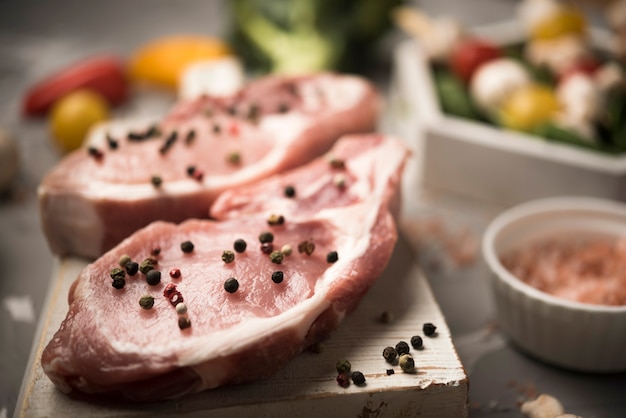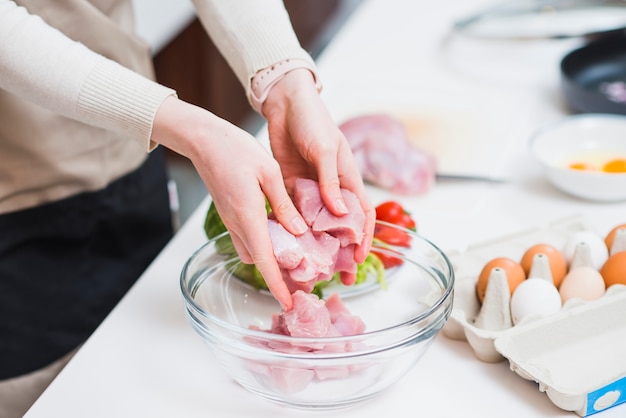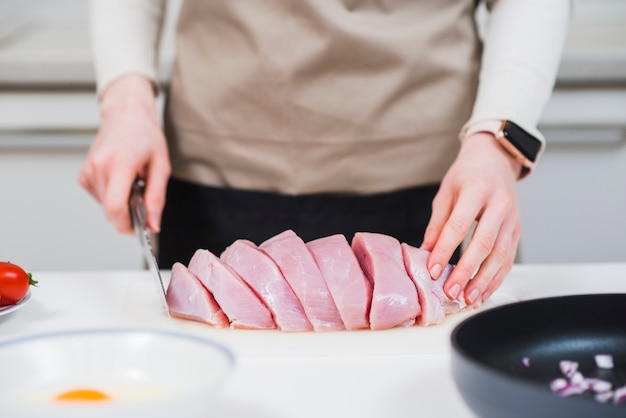(Part 1) The Reheating Methods: Choosing the Right Tool for the Job

1. Oven Reheating: The Classic Choice
The oven is a reliable and tried-and-true method for reheating a whole ham. It's gentle and even, ensuring the ham cooks through without drying out.I find that the oven creates the best balance between moisture and texture. The key is to use the foil as a moisture trap, allowing the ham to reheat slowly and evenly. This method is particularly effective for whole hams, as it gives you the most consistent results.
Tips for Oven Reheating:
- Preheat your oven to 325°F (160°C). A low temperature is crucial for preventing the ham from becoming too dry.
- Place the ham in a roasting pan, fat-side up. This allows the fat to render and add moisture to the ham.
- Cover the ham tightly with foil. The foil traps steam, creating a moist environment for reheating.
- Reheat for about 15-20 minutes per pound. This is a general guideline, but you'll need to check the internal temperature for accuracy.
- Uncover the ham for the last 15 minutes of cooking to allow the glaze to caramelize. This creates that beautiful, glossy finish and adds a lovely caramelized flavor.
2. slow cooker Reheating: The Set-It-and-Forget-It Approach
If you're looking for a hands-off reheating method, the slow cooker is your best friend. It's perfect for those days when you have a busy schedule but want to ensure a perfectly moist and flavorful ham.The slow cooker works its magic by gently reheating the ham in a moist environment. It allows the ham to simmer in its own juices, resulting in a tender and juicy finished product. The slow cooker's gentle heat is ideal for larger hams, as it prevents them from becoming dry.
Tips for Slow Cooker Reheating:
- Place the ham in the slow cooker, fat-side up. This encourages the fat to render and keep the ham moist.
- Add about 1 cup of liquid, such as apple juice, water, or broth. This creates a moist cooking environment and adds a subtle flavor to the ham.
- Cook on low heat for 4-6 hours, or on high heat for 2-3 hours. Adjust the cooking time depending on the size of the ham and the desired level of doneness.
- You can add a glaze or herbs during the last hour of cooking. This will infuse the ham with additional flavor and create a beautiful, glazed finish.
3. instant pot Reheating: The Speed Demon
The Instant Pot is a modern marvel, capable of reheating a ham quickly and efficiently. It’s a great choice if you need a hot ham on the table fast, but remember to check the internal temperature to ensure it's cooked through.The Instant Pot's high-pressure environment cooks the ham rapidly and evenly, while the steam helps to keep it moist. It's an excellent choice for busy weeknights or when you need a quick meal. However, remember to adjust the cooking time based on the size of the ham.
Tips for Instant Pot Reheating:
- Add a cup of water or broth to the Instant Pot. This creates steam for a moist cooking environment.
- Place the ham in the pot, fat-side up. This helps to keep the ham moist and prevent it from sticking to the bottom of the pot.
- Close the lid and set the valve to "sealing." This traps the steam and creates the high-pressure environment needed for cooking.
- Cook on high pressure for 10 minutes for a 10lb ham. Adjust the cooking time based on the size of your ham.
- Let the pressure release naturally for 10 minutes, then release the remaining pressure manually. This allows the ham to cook evenly and prevents it from being tough.
4. Stovetop Reheating: The Quick and Easy Fix
This method is perfect for smaller portions of ham, or if you're looking for a quick and easy reheating option. It's not ideal for a whole ham, but it's great for reheating leftover ham for a quick sandwich or snack.The stovetop method works by gently simmering the ham in water or broth, ensuring even cooking and a moist texture. However, this method requires constant monitoring to ensure the ham doesn't overcook. It's best suited for smaller portions or for reheating a ham that's already been cooked.
Tips for Stovetop Reheating:
- Place the ham in a saucepan. Choose a saucepan large enough to accommodate the ham comfortably.
- Add enough water or broth to cover the bottom of the pan. This will create a moist environment for reheating.
- Cover the pan and simmer over medium heat for 10-15 minutes, or until the ham is heated through. Check the internal temperature to ensure it's reached 140°F (60°C).
(Part 2) Reheating Times: A Guide to Prevent Overcooking

Reheating Times for a 10lb Fully Cooked Ham
| Reheating Method | Reheating Time (approx.) |
|---|---|
| Oven | 2.5-3 hours at 325°F (160°C) |
| Slow Cooker | 4-6 hours on low or 2-3 hours on high |
| Instant Pot | 10 minutes on high pressure |
| Stovetop | 15-20 minutes on low heat |
Important Note:
Remember, the internal temperature of the ham should reach at least 140°F (60°C) for safe consumption. Always use a meat thermometer to check the internal temperature, especially when using the Instant Pot.
(Part 3) The Ham: Knowing Your Ingredient

Ham Types: Understanding the Differences
- Bone-in: These hams will generally take a little longer to reheat because the bone acts as a heat sink, slowing down the cooking process.
- Boneless: These hams reheat faster because there’s no bone in the way to absorb heat.
- Spiral-sliced: These are already partially cooked, so they’ll reheat more quickly.
- Whole: These are the most common type of ham, and they’ll take the longest to reheat.
Size and Shape: The Impact on Reheating Time
A 10lb ham is a substantial piece of meat, requiring a longer reheating time compared to a smaller ham. If your ham has a more complex shape, with lots of crevices, it will also take a little longer to reheat evenly.
(Part 4) The Art of Glazing: Adding the Finishing Touch
Reheating isn't just about getting the ham hot – it's about elevating its flavor and presentation. A glaze, applied during the final stages of reheating, adds a touch of sweetness, shine, and irresistible aroma.Glaze Ideas: Adding Flavor and Visual Appeal
- Honey Glaze: A classic and always delicious, perfect for a sweet and tangy glaze. Combine honey, Dijon mustard, and a little bit of apple cider vinegar for a truly irresistible glaze.
- brown sugar glaze: Adds a lovely caramelized flavor to the ham. Mix brown sugar, maple syrup, and a touch of bourbon for a deep and rich glaze.
- maple glaze: Sweet and rich, a great choice for a more sophisticated glaze. Combine maple syrup, Dijon mustard, and a pinch of smoked paprika for a slightly smoky and complex glaze.
- Mustard Glaze: A tangy and savory option, great for those who prefer a more subtle sweetness. Mix Dijon mustard, honey, and a touch of apple cider vinegar for a bold and flavorful glaze.
Glazing Techniques: Achieving the Perfect Finish
It’s best to add the glaze during the last 15-30 minutes of cooking. This gives the glaze time to melt and caramelize, creating a beautiful, glossy finish. You can brush the glaze directly onto the ham, or you can use a basting brush to distribute it evenly.
(Part 5) The Don’ts of reheating ham: Avoiding Disasters
There are some common pitfalls to avoid when reheating ham. These mistakes can lead to a dry, tough ham that's less than appetizing.1. Overheating: The Dry Ham Disaster
Overheating is the number one enemy of a moist and tender ham. The high temperature will dry out the ham, resulting in a tough, rubbery texture. Reheat the ham slowly and evenly, using a low temperature and monitoring the internal temperature closely.
2. Not Covering the Ham: Loss of Moisture
Remember the importance of moisture. Leaving the ham uncovered during reheating will allow the moisture to escape, leaving a dry and unappetizing ham. Always cover the ham with foil or a lid during the reheating process to retain moisture.
3. Neglecting the Internal Temperature: food safety First
This is not something to be taken lightly. Ham needs to reach a safe internal temperature of 140°F (60°C) to be considered safe for consumption. Always check the temperature using a meat thermometer to ensure that the ham has reached the safe internal temperature and prevent foodborne illness.
4. Reheating It Too Many Times: Quality Degradation
Reheating ham multiple times can further dry it out. It's best to reheat it once and serve it immediately. If you have leftovers, store them in the refrigerator and reheat them the next day.
(Part 6) Beyond the Basics: Leftover Ham Inspiration
After you've successfully reheated your ham, you'll have plenty of delicious leftovers. Here are some creative ways to use up that leftover ham.Leftover ham recipes: Get Creative and Delicious
- Ham and bean soup: A hearty and comforting soup that uses up the leftover ham and is perfect for a cold winter day.
- Ham Salad Sandwiches: A classic sandwich filling that's perfect for a quick lunch or picnic.
- ham and cheese quiche: A delicious and savory quiche that's perfect for brunch or dinner.
- Ham fried rice: A flavorful and easy dish that’s great for a quick and satisfying meal.
- Ham and Potato Hash: A hearty and filling dish that's perfect for breakfast, brunch, or dinner.
Storage Tips: Keeping Leftovers Safe and Tasty
Leftover ham should be stored in the refrigerator in an airtight container for up to 4 days. You can also freeze leftover ham for up to 2 months. When freezing, wrap the ham tightly in plastic wrap and then aluminum foil to prevent freezer burn.
(Part 7) From My Kitchen to Yours: Personal Experiences and Tips
I've been there, staring at a large ham with no clue how to reheat it. But over the years, I've learned a few tips and tricks that have made reheating ham a breeze.My Top Reheating Tips: The Insider Secrets
- Start with a cold ham: It’s best to start with a cold ham because it will reheat more evenly.
- Don't forget to score the ham: Scoring the ham before reheating helps to allow the heat to penetrate more evenly and prevents it from drying out.
- Basting is your friend: Basting the ham with the juices or a glaze throughout the reheating process will keep it moist and flavorful.
- The internal temperature is key: Don’t just rely on visual cues. Use a meat thermometer to ensure that the ham has reached the safe internal temperature of 140°F (60°C).
(Part 8) FAQs: Your Ham Reheating Questions Answered
Let's tackle those burning questions you might have about reheating a ham.1. Can I reheat a ham in the microwave?
While it's tempting, I wouldn't recommend reheating a ham in the microwave. It can lead to uneven heating and dry, tough ham. The microwave's intense heat can also make the ham rubbery.2. How long should I reheat a spiral-sliced ham?
Since spiral-sliced hams are already partially cooked, they generally need less time to reheat. You can reheat them in the oven for 30-45 minutes at 325°F (160°C) or on the stovetop for 10-15 minutes.3. Can I reheat a ham from frozen?
You can reheat a ham from frozen, but you'll need to add extra time to the reheating process. Allow about 30-45 minutes per pound for a frozen ham in the oven, or 5-7 hours on low in the slow cooker. It's best to thaw the ham in the refrigerator overnight before reheating to ensure even cooking.4. What happens if I overcook the ham?
Overcooked ham can be dry and tough. If you've overcooked the ham, try adding some moisture by basting it with some broth or juice. You can also try shredding the ham and using it in a soup or other recipe.5. What's the best way to serve a reheated ham?
A reheated ham is delicious served with a variety of sides, such as mashed potatoes, sweet potatoes, green beans, or a salad. You can also serve it with a simple glaze or sauce.And there you have it, a complete guide to reheating a 10lb ham with confidence. Now go forth and conquer those ham-reheating challenges!Everyone is watching

How to Cook Frozen Lobster Tails Perfectly: A Step-by-Step Guide
RecipesLobster. Just the word conjures up images of lavish meals, special occasions, and a taste of luxury. But let's...

Pork Fillet Cooking Time: How Long to Cook It Perfectly
RecipesPork fillet, or tenderloin as it's sometimes called, is a real favourite in our house. It's so versatile, and...

Pigs in a Blanket Cooking Time: How Long to Bake for Perfect Results
RecipesAh, pigs in a blanket. Just the name conjures up images of those delightful little parcels of crispy pastry en...

The Ultimate Guide to Cooking Delicious Frankfurters
RecipesLet's face it, we all love a good frankfurter. It's a classic, simple, and always satisfying. But let's be rea...

Wolf Meat Recipes: A Guide to Cooking Wild Game
RecipesLet's be honest, you don't see wolf meat at your local butcher shop every day. It's a bit of a wild card, but ...
